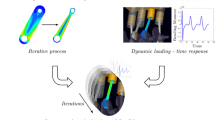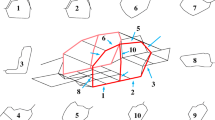Abstract
In the traditional approach to analysing and optimizing frame structures, joints are assumed to be rigid. Research has shown, however, that flexibility in the joints of a structure has a great effect on its behaviour. In this paper we present a formal method for optimizing frame structures to account for joint flexibilities and their design parameter sensitivities. We also present a simplified method that accounts for joint flexibility in the initial configuration, but neglects sensitivities to the design parameters. In a case study on an automotive sub-frame structure we compare optimization results using the traditional rigid joint model and the flexible joint methods proposed here. Results suggest that the simplified flexible joint method is more accurate than the traditional rigid joint model, and provides a more conservative design than the full flexible joint method while saving physical and computational effort.
Similar content being viewed by others
Author information
Authors and Affiliations
Additional information
Received January 18, 1999
Rights and permissions
About this article
Cite this article
Cameron, T., Thirunavukarasu, A. & El-Sayed, M. Optimization of frame structures with flexible joints. Struct Multidisc Optim 19, 204–213 (2000). https://doi.org/10.1007/s001580050103
Published:
Issue Date:
DOI: https://doi.org/10.1007/s001580050103




